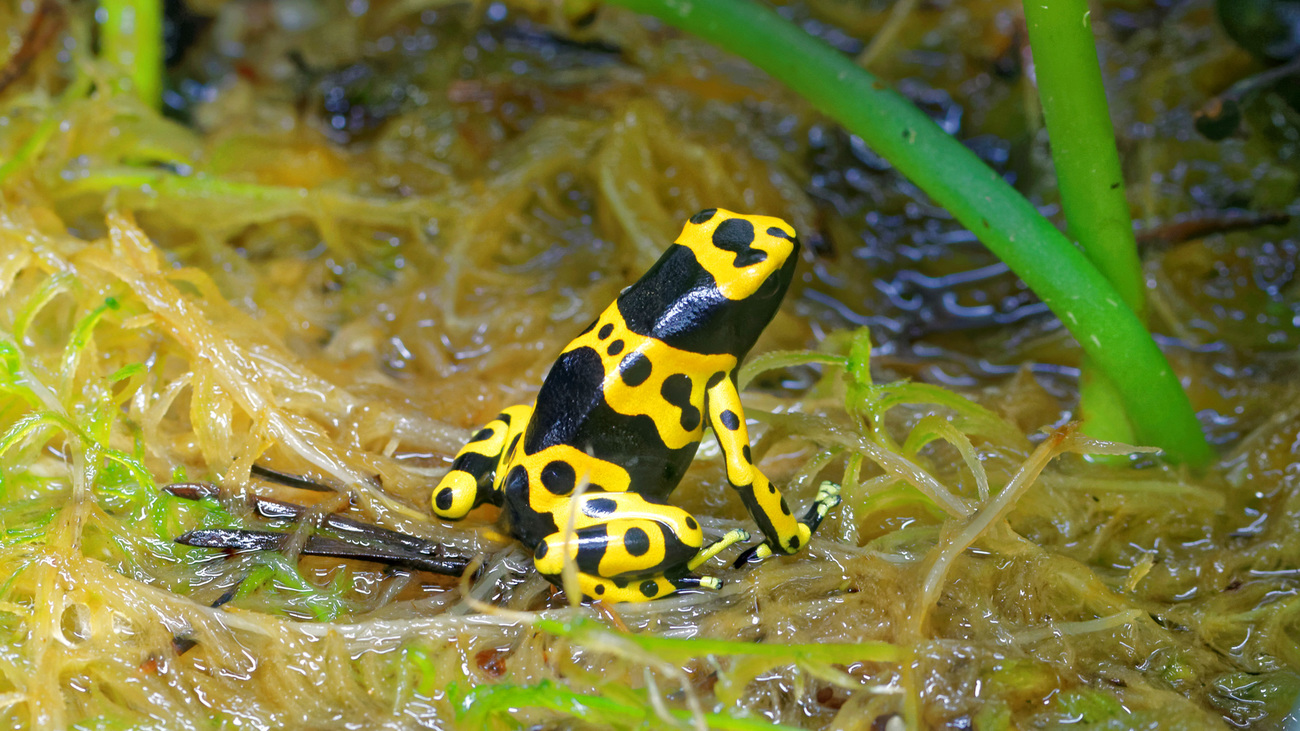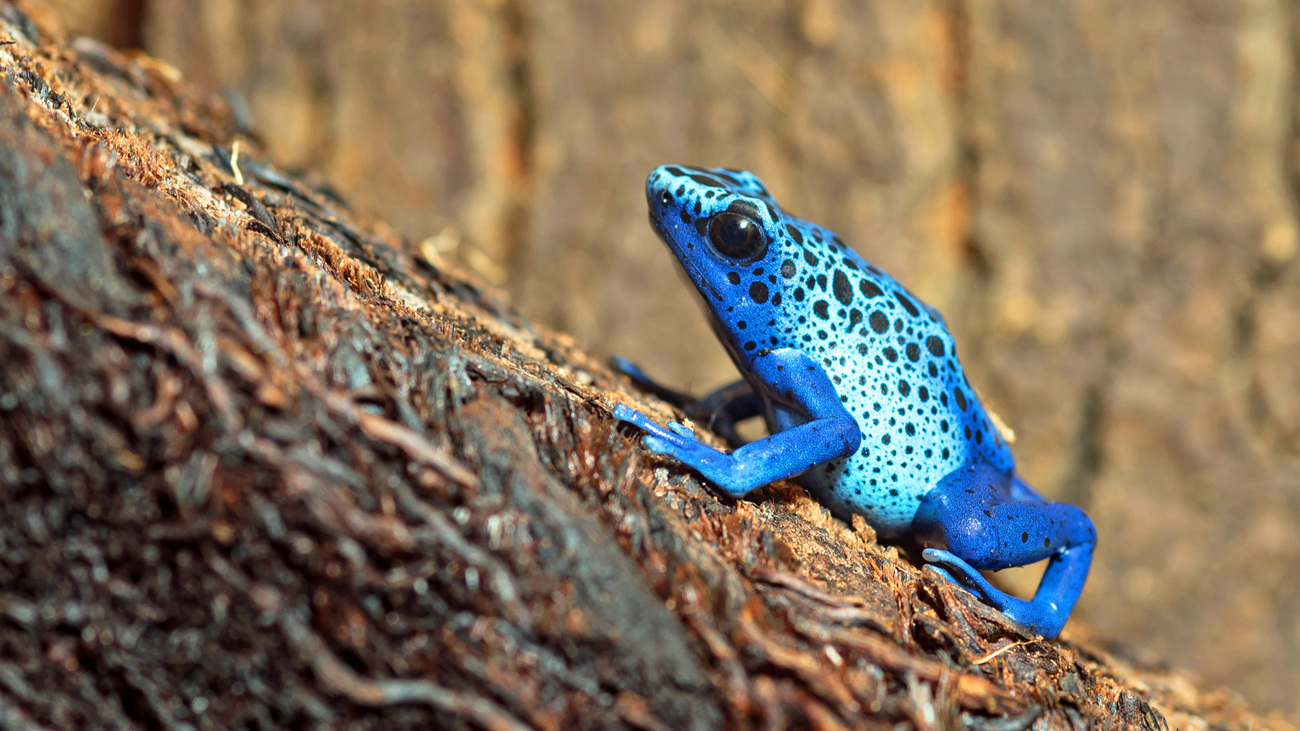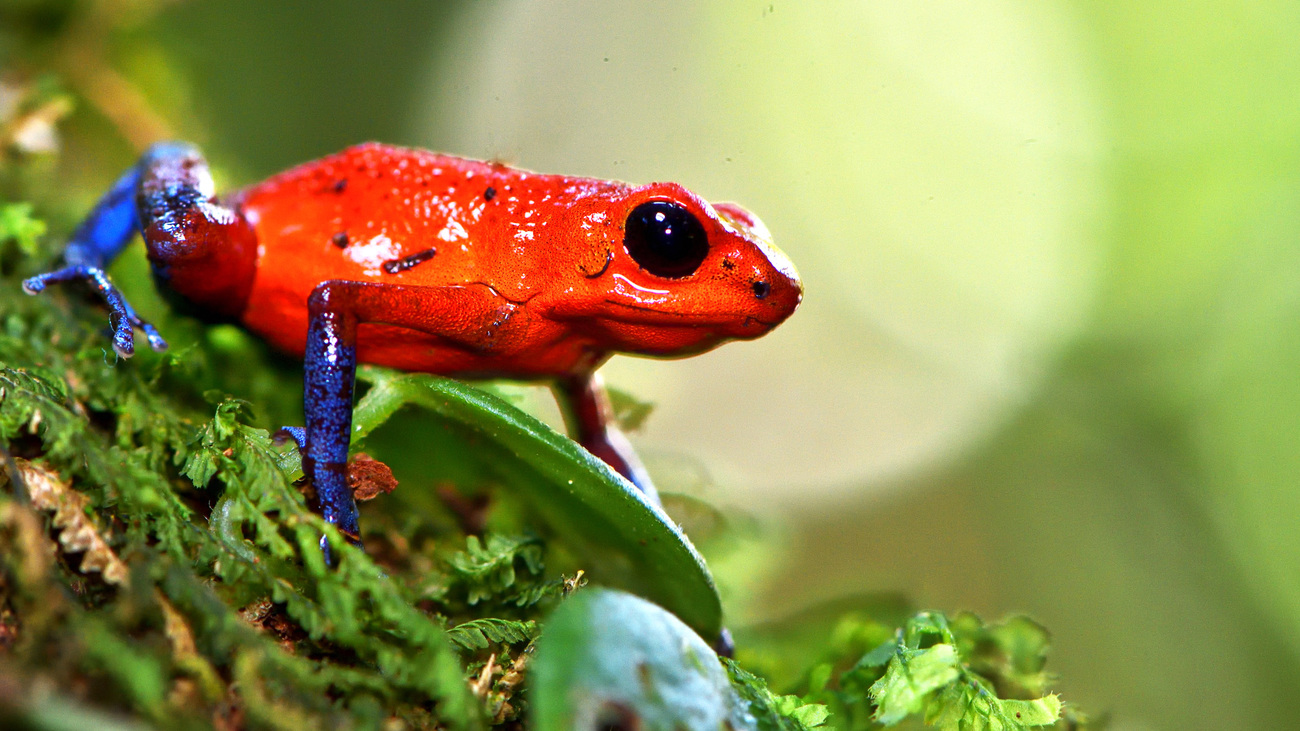Poison dart frogs
Found in Central and South America, poison dart frogs (also known as poison arrow frogs) are small amphibians known for their bright colors. They are so named because indigenous tribes used to collect the frogs’ poison and apply it to the tips of their arrows and darts before hunting.
The striking colours of a poison dart frog’s skin warn its predators about its toxicity. They are typically less than 1.5 centimetres (0.59 inches) long, though some can grow up to 6.5 centimetres (2.4 inches) long. They primarily eat ants, termites, and other small invertebrates, which they catch easily with their quick, sticky tongues. Unlike most other types of frogs, poison dart frogs are diurnal, meaning they are active during the day, often hopping around the forest floor in search of prey.
Poison dart frogs also have unique reproduction habits. Males perform an elaborate courtship dance to attract females. Usually, more than one female will respond to a male’s call and will fight aggressively until there is a winner. The victorious female will rub her front legs against the male’s snout and back, and then they will go somewhere secluded to mate. She will lay her eggs on the forest floor, and the male will guard them and keep them moist. After hatching, the male carries the tadpoles on his back to a water source, where they develop into froglets.
Despite their small size, poison dart frogs are very important to their environments. Their diet plays a crucial role in controlling insect populations and preventing plants from being overconsumed. If poison dart frogs were to go extinct, it would cause major ecological problems in the forests of Central and South America. There would be an increase in insects and a decrease in larger animals—like lizards, snakes, and birds—who rely on these frogs as a food source.
The presence or absence of poison dart frogs in a particular ecosystem provides valuable information to scientists. It can signal changes in habitat quality and biodiversity, making them valuable for monitoring environmental health. Sadly, however, they are a threatened species due to habitat loss and degradation. They are also hunted for their skin.
What is a poison dart frog’s scientific name?
The scientific name for a poison dart frog is Dendrobatidae. There are many species of poison dart frogs, which all have their own scientific names, but they all belong to the Dendrobatidae family.
Are poison dart frogs endangered?
Poison dart frog is the common name for a group of many different frog species. They have varying classifications and conservation statuses, which range from least concern to critically endangered.
Some of the most threatened subspecies include:
- The Oxapampa poison frog, which is critically endangered and only found in a singular location in Peru (logging and timber harvesting threaten its existence)
- The black-legged poison dart frog, which has an endangered and decreasing population and is threatened by agriculture and mining
- The sky blue poison dart frog, which is an endangered species living in the caves and forests of Peru (its two main threats are hunting and agricultural practices)
- Boehmei’s poison arrow frog, which is an endangered subspecies found only in a small area of the Bolivian wetlands and is under constant threat by livestock farming and ranching
- Silverstone’s poison frog, which has an endangered population found in only two locations in Peru and faces continual population decline due to local farming and hunting operations
Where do poison dart frogs live?
Poison dart frogs are found in the tropical rainforests of Central and South America, from Nicaragua to Peru and Brazil.
Within these regions, poison dart frogs prefer specific microhabitats like leaf litter, rotting logs, and vegetation near streams or other bodies of water. They require high humidity and relatively stable temperatures, which is why they inhabit rainforests.
Threats
Poison dart frogs face a number of serious threats, which have placed many species on the IUCN Red List. Habitat loss due to deforestation, pollution, logging practices, the exotic pet trade, and a devastating deadly fungus all threaten poison dart frogs and the ecosystems they inhabit.

Habitat loss
Rapid deforestation and land development in rainforests have led to the destruction of poison dart frog habitat.
To clear the land for agricultural activities, including cattle pastures and tea farms, people burn rainforests. Though this might be an effective means of improving and expanding pasture land for cattle, it decimates local wildlife populations. Some poison dart frogs are caught in the flames, and those who are lucky enough to escape are left with nowhere to live. In 2019 alone, human-induced fires burned around 30,000 hectares of rainforest habitat.
As human population numbers rise and urban areas expand, poison dart frog habitats are also being cleared for residential development.
Pollution
Illegal crop spraying indirectly affects poison dart frogs. Farmers spray their crops with poisons to deter and kill pests, but this practice is done with little regard for other wildlife living nearby. In many of the areas in which these frogs live, increasing amounts of agrochemical substances have been detected in the soil and water, damaging their ecosystems.
Logging
Frogs are cold-blooded and rely on the shade of trees to cool down, which is why they are mostly found in cool, forested areas. Without these trees to regulate their temperature, they risk overheating and dying.
The strawberry poison frog, so named for its distinctive red colour, has already been observed struggling to survive in the heat in certain parts of South America. Even in shady areas, such as under fallen trees left behind by loggers, temperatures are still at the upper end of what these frogs can tolerate.
Pet trade
Poison dart frogs have been subject to heavy trafficking and smuggling activity over the past 15 years, as their bright colours make them seem like attractive pets. You can often find them in local pet shops with no explanation of how endangered they are in the wild.
While many poison dart frogs that are sold as pets have been bred in captivity, there is still a thriving illegal pet trade in South America, despite attempts of intervention by local governments and individuals.
Deadly fungus
A fungus called Batrachochytrium dendrobatidis (known as Bd) is present within poison dart frog habitats.
This fungus can cause a disease which affects the skin of amphibians. Because frogs are so reliant on their skin—for temperature regulation, respiration, and water intake—this disease can easily be deadly.
Bd is believed to have spread globally through the international trade of amphibians. Once it’s introduced to new habitats, it can quickly decimate local frog populations.
FAQs
What do poison dart frogs eat?
A poison dart frog’s diet is made up of small invertebrates, like ants, termites, mites, and small insects. They use their sticky tongues to capture their prey.
Is a poison dart frog a carnivore?
As poison dart frogs eat insects and other animals, they are carnivores. However, as tadpoles, they are omnivorous, eating algae and plant matter as well.
Can you touch a poison dart frog?
Poison dart frogs secrete toxins through their skin that can be potentially harmful to humans. While not all species of poison dart frogs are equally toxic, some can produce extremely potent toxins. In fact, some species of frogs’ secretions are so toxic that rubbing the tip of a dart across its back will gather enough poison to kill a monkey or small bird.
Poisonous or not, it’s never a good idea to touch any animals in the wild.

How do poison dart frogs get their poison?
Scientists have not determined the exact method through which poison dart frogs become toxic. One common theory is that the frogs absorb the poison that is present in the prey they consume. The toxins are then synthesised by their bodies and stored in their skin glands.
When poison dart frogs are raised in captivity and fed a diet that lacks these toxic prey, they do not develop the same level of toxicity as their wild counterparts.
Are all dart frogs poisonous?
While many dart frogs are known for being very poisonous, not all species of poison dart frogs secrete these toxins. The general rule of thumb is that the brighter-coloured frogs tend to be more poisonous than the brown and dull-coloured dart frogs.
Are dart frogs poisonous or venomous?
Dart frogs are poisonous. While poisonous organisms, like dart frogs, have toxins in their bodies or skin which can be harmful when ingested or touched, venomous organisms inject their toxin into their prey. An example is a snake that uses its fangs to release its venom upon biting its prey.
Poison dart frogs secrete toxins through their skin. These toxins can cause reactions ranging from mild numbness to paralysis and death.
How much poison is in a poison dart frog?
The amount of poison in dart frogs varies wildly based on the species. Some are not poisonous at all, while others carry and secrete a toxin that can be 200 times more potent than morphine.
Can a poison dart frog kill an elephant?
While not all poison dart frogs secrete lethal toxins, the golden poison frog has a poison which is potent enough to kill an elephant.
The poison in just one golden frog’s skin can kill 10,000 mice, between 10 and 20 adult humans, or two elephants. The poison it secretes prevents nerves from firing, causing muscles to remain in constant contraction, leading to heart failure.
What eats poison dart frogs?
Due to their highly toxic skin, poisonous dart frogs only have one natural predator, a species of snake that has developed a resistance to their venom over time.
Where are poison dart frogs found?
Poison dart frogs can be found in the rainforests of Central and South America.
Are poison dart frogs nocturnal?
Unlike the majority of other frog species, poison dart frogs are actually diurnal. This means they are most active during the day and sleep at night.
How big are poison dart frogs?
The size of poison dart frogs varies by species. The smallest frogs are less than two centimetres (0.8 inches) long, while the biggest are around 6.5 centimetres (2.6 inches) long.

Can poison dart frogs swim?
Technically, poison dart frogs can swim, but they’re not very good at it. Without webbed toes, swimming is hard for them, but they can happily live in and around water.
How do poison dart frogs mate?
The poison dart frog mating ritual starts with a male calling females to come to mate with him. Usually, multiple female frogs respond, which results in a physical fight to determine the winner.
The male then takes the victorious female back to a spot he’s found for mating, secluded but near a body of water. Once they have mated and she has laid the eggs, the male guards the clutch and keeps them moist until they hatch. Then he gathers the tadpoles on his back and transports them to a body of water where they can complete their development.
Why are poison dart frogs endangered?
Poison dart frogs face a number of threats, causing many species to become endangered. These include deforestation and logging, pollution from pesticides, and agricultural and mining practices.
These frogs are also frequently hunted and captured for the illegal pet trade, prized for their bright colours and rarity.
How many poison dart frogs are left in the world?
The exact number of poison dart frogs left in the wild is unknown, but we do know that many species have declining populations, including the: green and black poison frog, Cainarachi poison frog, emerald poison frog, and pleasing poison frog.
Can you own a poison dart frog?
You should not seek a poison dart frog as a pet. The exotic pet trade is an incredibly cruel practice that impacts poison dart frogs. The increasing demand for poison dart frog pets has led to illegal poaching which threatens the already-dwindling populations of these frogs.
Are poison dart frogs poisonous in captivity?
Poison dart frogs that are raised in captivity are not poisonous. Wild frogs absorb toxins from the insects they eat in their natural habitat. In captivity, when isolated from these insects and fed a non-toxic diet, they become non-poisonous.
However, it is not good practice for poison dart frogs to be kept in captivity. The illegal trade of these frogs is endangering many species.
How can you help?
Because poison dart frogs are threatened by deforestation, pollution, logging practices, and the exotic pet trade, it’s up to us to help them. You can learn more and educate others about the dangers of the exotic pet trade with our interactive quiz, and you can support conservation and policy initiatives that work to prevent threats to endangered wildlife.
